Customizing Buildings I and Feb 2012 Status
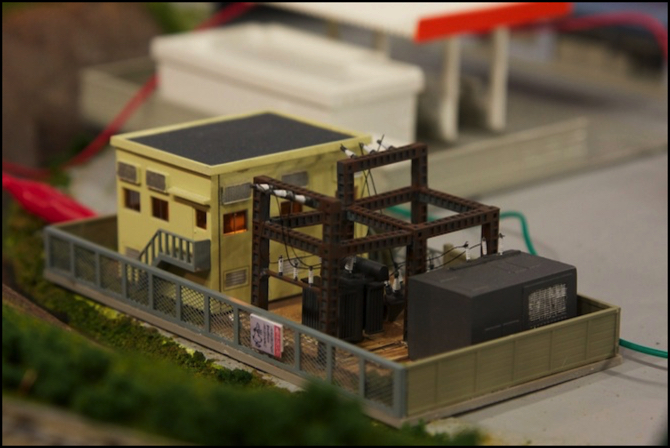
I’ve always enjoyed building plastic models. When I was a kid I made many, many models of ships, planes, tanks, spaceships, dinosaurs and whatever else caught my interest. This included some train car kits for my HO layout. Some I even painted moderately well. The less said about my decaling skills, however, the better.
But sometime in High School I lost interest, and it wasn’t until working on the first adult HO layout that I dusted off my skills for some new kits, and also did some customization of kits (commonly known as “kitbashing” in the model railroad hobby). But until this year, those skills had languished again.
When I started with the first N-scale layout, I bought ready-built model buildings, mostly from Kato. This was partly because my focus was on the trains, but mostly due to a lack of time to devote to doing a model “right”. But it’s always been my intent that those ready-built structures would get customized. Maybe not a full-on kitbash, but a good non-glossy paint job, interiors, lighting, and some details were in order.
This is also a chance for me to hone my skills. If I screw up here, I’m out a $40 model and some time, but not a huge investment in either sense. Eventually I plan to scratchbuild some structures, and I really don’t want to mess up something I’ve put dozens of hours into because my painting skills aren’t up to snuff. So here I can make mistakes with relative impunity. That takes most of the pressure off. That’s also why I did the substation kit first. It was $15 and a couple of hour’s work. A trial run for this project, and minimal risk.
Credit where it’s due: Although I know a lot of this from my own prior experiences, I’ve learned quite a bit over the last couple of years reading posts about other people’s model-building experiences on the JNS Forum, and in particular from Jerry’s postings over at Quinntopia.
Customizing Structures
Starting with the substation kit I described a couple of posts ago, I’m now launching that effort as part of completing the Village section of the River Crossing scene. You can see the completed Electrical Substation up above. It’s not yet in its final spot, and the roads and sidewalk around it have yet to be built, but the structure itself is done. It’s hard to tell from this photo, but there’s a simple interior, a couple of figures, and some grass and shrubs just inside the fence. And, as you can kind-of see, it’s lit with a pair of yellow LEDs to give it a “incandescent light” look. This was a kit, but I’m going to take a very similar approach in detailing the ready-built structures, and I’ll describe that in this and likely several subsequent posts.
Initial State: The Buildings
I’m working with several structures in parallel: A Tomix Gas Station (ENEOS, 4064), a Tomix Apartment Building (Apartment House with Red Roof, 4026), and two Kato Apartment Buildings (Gilbert Gardens Apartments, 23-402A and Roselle Road House, 23-402B). At this point the buildings are fresh from the box, assembled but none of the separate detail parts or stickers have been applied. And they’ve been sitting on the layout for several years, collecting a layer of dust and finger oils from repeated handling.
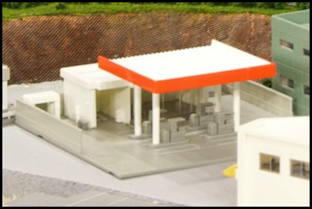
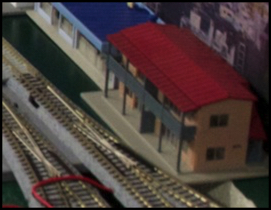
Before Work: Tomix Gas Station and Apartments
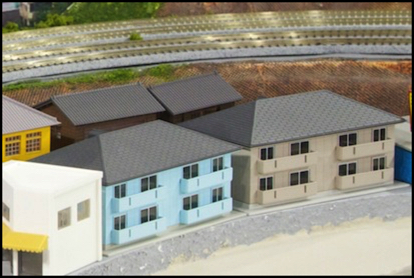
Before Work: Two Kato Apartments
Disassembly
First, the big complication with pre-built structures is that they’ve been put together, usually with some amount of glue, although these particular ones mostly snapped together. The two Kato buildings came off their bases fairly easily, as did the gas station (the roof over the pumps is actually held on with four screws). But the Tomix apartment building needed a bit of encouragement. Patience, a small flat-head jeweler’s screwdriver used as a pry-bar, and more patience gets the job done. I also needed a phillips-head screwdriver for a couple of screws.
Removing the “glass” was next, and mostly easy. The windows on all of these are one large sheet of plastic on each wall, with extended parts to fit into the window openings and with raised edges around those painted silver to look like window frames. Some of them were only held in place by each other, but some were glued in. Fortunately it wasn’t strong glue, and lots of gentle prying with a large jeweler’s screwdriver managed to separate them all without any breakage. I was careful to pry away from the windows, so any scratches are not visible. The hardest was the windows of the gas station. They main window was glued in, but gentle (but very forcefull) pulling eventually caused the glue to release. There’s also a side window I almost missed, which needed to be pried out with a very small jeweler’s screwdriver lifting one end until it could be pushed sideways to remove it. But at last they were all out.
With the windows out I removed the attached bits. The balconies on the Tomix apartment building were snapped in, but the tabs were not easily reached, and took a bit of care. The Kato buildings have balconies that snap on, but the tabs were very delicate and I broke several. Glue will be required when it comes to reassembly. Finally, the roof parts on the two Kato buildings are held on by two screws, and release easily. The roof of the Tomix building is part of the same molding as the walls, and doesn’t come off (that would prove a problem later). The two Kato buildings also had interior floors for the second level; just a simple flat sheet of plastic, held in place by bumps on the windows, but it will be useful for doing the interior.
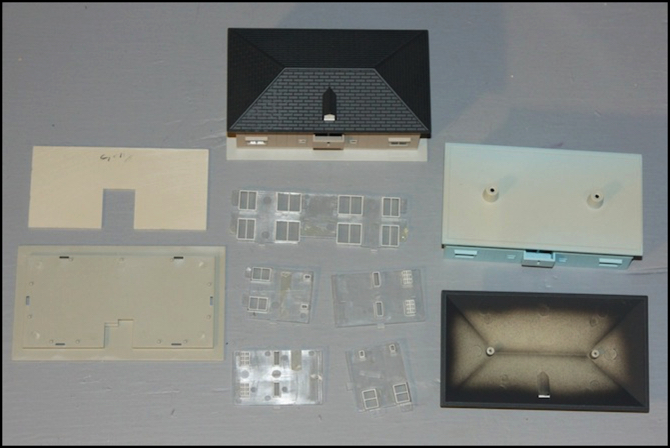
The Kato Gilbert Gardens Apartments apart, along with the Roselle Road House (together)
Planning
At this point, I stopped and did some planning on how I’ll structure the interiors and light the buildings. The gas station will need an SMD LED strip under the awning to light the pumps, and something (likely the same) inside the main building. No modifications are needed (well, I need to get power to the awning, but that comes later). I plan to use the “white” (aka bright white or cool white) strips I have for this, to simulate harsh fluorescent shop lighting.
The Tomix apartment building is pretty simple. A LED strip can go inside the roof and light the second floor (I’ll use “warm white” for this, to simulate a slightly warmer color; I don’t think I want to use yellow here, but I’m considering that for future house lighting). I’ll need to build a platform for the upper floor, but the same method I used on the electrical substation (a raised sheet of plastic with some legs) can work. I’ll probably not light the ground level due to space issues. I’m considering adding some kind of curtains inside the windows too, although that’s for a future phase of this work.
The Kato buildings are a bit harder. I might be able to put LED strips on the underside of the ceiling and floor unit, but there are obstructions (the interior stairwell) and clearance issues (it might be visible through the window). I’m going to try that for the ground level anyway, but I’m going to do something different on the upper level: cut holes in the ceiling and put the LED strip(s) in the roof.
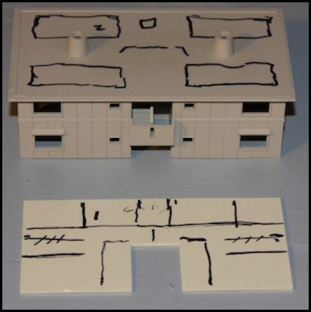
Floor sheet marked for walls and roof marked for cuts
I marked out where I wanted to cut the roof (and also marked a line where the edge of the stairwell was, so I wouldn’t cut into it) and marked the floor sheet where I wanted to make walls based on the lighting and window positions. I thought about building the actual floors at this point, but decided to put that off for now.
Then I broke out the dremel with a cutting wheel, attached the house to my workbench with a solid clamp (so my fingers wouldn’t be anywhere near the model; I like them attached, thanks), and cut out the large openings in the ceiling with two straight cuts and a diagonal to leave two triangles of plastic attached at only one end. A bit of work bending and snapping removed the these, and a file cleaned up the edges. I didn’t take a good picture of this stage, but you can see the cut-outs in later ones.
Cleaning
Even if these models hadn’t been collecting dust and fingerprints for several years, cleaning them would be the next step. This is important to remove any oils or other compounds left on the body from the manufacturing process or added later by handling (less likely where these were painted rather than bare plastic, but still a good idea). A quick wash in a tub of lukewarm water (not hot) with a small amount of dish detergent and a scrub with an old and well-worn discarded toothbrush, followed by a rinse in running water to remove any soap, and then they were placed on some paper towels on the table to air-dry overnight. I didn’t clean the windows since those aren’t going to be painted, and looked clean enough.
Note: I wear gloves for this, partly so my hands don’t turn into prunes, but mostly so I don’t put oils back onto the model. I buy disposible nitrile gloves by the carton. For all of this cleaning and painting work I’m using powder-free gloves (not the powdered kind sold in house paint stores; I get these at an auto parts store).
Masking and Painting: Interior
Now since I’m going to light these, the next step is to paint the interior to make them opaque, as I only want the light to shine out the windows. Model building plastic is translucent, not opaque, and the whole thing will glow if not painted. The exterior paint might be enough to avoid a problem, but I’m not taking any chances.
I used blue painter’s masking tape for this. It’s crude, and doesn’t stick to plastic as well as some other masking materials might, but for what I need at this point it’s good enough, and cheap. Basically I wrapped the exterior of the structure that wasn’t getting painted so that overspray wouldn’t get on it (spray paint goes around corners surprisingly well, at least when you don’t want it to). This also protects the outside from stray paint marks from handling it while painting, as my gloves usually end up with a bit of paint on the fingertips.
And that’s a good point to drive home: spray paint goes places you don’t intend it to go. There are four things I always wear when painting with spray paint, old clothes I don’t mind getting paint on, disposible nitrile gloves to protect my hands from overspray and handling, safety glasses to protect my eyes (you’d be surprised how often I point the can in the wrong direction, although never yet at my face) and finally a good respirator with fresh organic solvent cartridges.
And finally, I painted the interior of the buildings, the underside of the two separate roofs, and the underside of the gas station awning. All of these received two coats of Testor’s Flat Black as a light block. Two coats ensures I don’t miss a spot, as usually there is some part I overlook the first time, and don’t notice until I go to make the second coat. This is followed by white (this time around I’m using Tamiya white primer, as the other white’s I’ve used I haven’t liked). This doesn’t cover well, but dries very quickly, so a number of light coats can be put on in quick succession until the black is covered. I had some overspray problems as the tape came loose in a few places, and I’ll probably eventually apply primer to the outside also.
And here’s where the attached roof of the Tomix apartment building became a problem. I don’t know if the narrow confines caused me to spray too much, or if the closed space made it slow to evaporate, but the flat black sprayed into this one building stayed wet for more than an hour, much longer than any of the others. That complicated things a little for me, since it wasn’t ready for the white paint when all of the other models were, and I didn’t want to leave them to dry for too long before applying the white paint.
I did the painting assembly-line style: doing all of the wall and roof units in a batch, then letting them all dry. I won’t do this when applying separate colors to things (although I’ll probably do those at close to the same time), but here I don’t need to worry about overspray, and this way I only need to clean the spray can nozzle once after doing a coat on all of the buildings (cleaning the nozzle wastes paint).
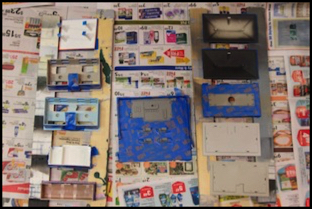
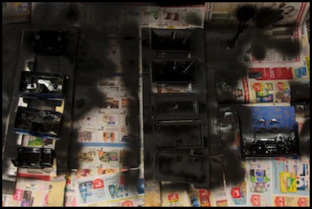
Assembly Line Painting: before, and after first coat of black (still wet here, which is why it’s glossy)
Paint is odd: you can apply multiple coats after the first dries, but only for a couple of hours. After that, the paint needs to be left to cure for a day or two (the Testor’s can recommended 48 hours), otherwise a later coat will cause the first coat to develop small cracks (called crazing). So, now that I’ve applied my interior paint, I’m going to let things sit for a couple of days before removing the tape and painting the exterior.
I can spend that time working on interiors for the three apartment buildings, which are going to be a combination of plastic walls/floors and glued-on photos for flooring, wallpaper, etc. You won’t be able to see much through the windows, but all three will be in prominent locations, so the interiors will be visible and I want them to look good. The gas station will get a similar treatment. It came with stickers for the interior, but I’ll probably use photos there too. But that’s a topic for another day.
Monthly Status: February 2012
February went to work on the River Crossing, starting with the backdrops and then ground cover and the beginnings of the actual structure work. There’s not really any more to say there. I have plenty of other things I could also work on, but for now finishing up this scene is my focus, and probably will be for another couple of months at the current pace.



